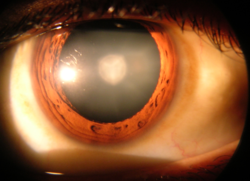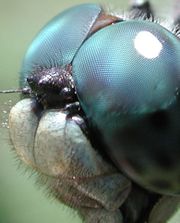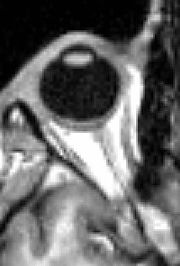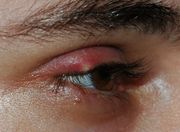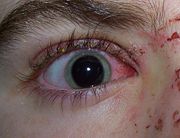Eye
2008/9 Schools Wikipedia Selection. Related subjects: Health and medicine
| Eye | |
|---|---|
| Schematic diagram of the human eye. | |
| Human Eye Anterior Segment - Magnified view seen on examination with a slit lamp under diffuse illumination showing conjunctiva overlying the white sclera, transparent cornea, pharmacologically dilated pupil and cataract | |
| Latin | segmentum anterius bulbi oculi |
| Dorlands/Elsevier | s_07/13264628 |
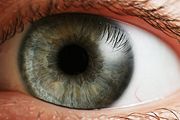
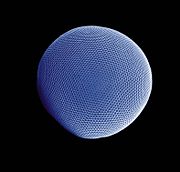
Eyes are organs that detect light. Different kinds of light-sensitive organs are found in a variety of animals. The simplest "eyes", in even unicellular organisms, do nothing but detect whether the surroundings are light or dark, which is sufficient for the entrainment of circadian rhythms and may allow the organism to seek out or avoid light, but hardly can be called vision.
Overview
More complex eyes can distinguish shapes and colors. The visual fields of some such complex eyes largely overlap, to allow better depth perception ( binocular vision), as in humans; and others are placed so as to minimize the overlap, such as in rabbits and chameleons.
The first proto-eyes evolved among animals 540 million years ago, about the time of the so-called Cambrian explosion. Almost all animals have eyes, or descend from animals that did. In most vertebrates and some mollusks, the eye works by allowing light to enter it and project onto a light-sensitive panel of cells, known as the retina, at the rear of the eye. The cone cells (for colour) and the rod cells (for low-light contrasts) in the retina detect and convert light into neural signals. The visual signals are then transmitted to the brain via the optic nerve. Such eyes are typically roughly spherical, filled with a transparent gel-like substance called the vitreous humour, with a focusing lens and often an iris; the relaxing or tightening of the muscles around the iris change the size of the pupil, thereby regulating the amount of light that enters the eye, and reducing aberrations when there is enough light.
The eyes of cephalopods, fish, amphibians and snakes usually have fixed lens shapes, and focusing vision is achieved by telescoping the lens—similar to how a camera focuses.
Compound eyes are found among the arthropods and are composed of many simple facets which, depending on the details of anatomy, may give either a single pixelated image or multiple images, per eye. Each sensor has its own lens and photosensitive cell(s). Some eyes have up to 28,000 such sensors, which are arranged hexagonally, and which can give a full 360-degree field of vision. Compound eyes are very sensitive to motion. Some arthropods, including many Strepsiptera, have compound eyes of only a few facets, each with a retina capable of creating an image, creating multiple-image vision. With each eye viewing a different angle, a fused image from all the eyes is produced in the brain, providing very wide-angle, high-resolution images.
Possessing detailed hyperspectral colour vision, the Mantis shrimp has been reported to have the world's most complex colour vision system. Trilobites, which are now extinct, had unique compound eyes. They used clear calcite crystals to form the lenses of their eyes. In this, they differ from most other arthropods, which have soft eyes. The number of lenses in such an eye varied, however: some trilobites had only one, and some had thousands of lenses in one eye. The largest eye ever to be reported measures 27 cm in diameter and belongs to a Colossal squid specimen.
In contrast to compound eyes, simple eyes are those that have a single lens. For example, jumping spiders have a large pair of simple eyes with a narrow field of view, supported by an array of other, smaller eyes for peripheral vision. Some insect larvae, like caterpillars, have a different type of simple eye ( stemmata) which gives a rough image. Some of the simplest eyes, called ocelli, can be found in animals like some of the snails, which cannot actually "see" in the normal sense. They do have photosensitive cells, but no lens and no other means of projecting an image onto these cells. They can distinguish between light and dark, but no more. This enables snails to keep out of direct sunlight.
Evolution of eyes
Biologists explain the origin and development of eyes, as well as of organs in general, by use of the principles of evolution.
The common origin ( monophyly) of all animal eyes is established by shared anatomical and genetic features of all eyes; that is, all modern eyes, varied as they are, have their origins in a proto-eye evolved some 540 million years ago.

The earliest "eyes", called eyespots, were light-sensitive proteins in unicellular organisms. In multicellular organisms, simple patches of photoreceptor cells are physically similar to the receptor patches for taste and smell. Eyespots and flat eye patches can only sense ambient brightness: they can distinguish light and dark, but not the direction of the lightsource. Thus, they are sufficient for synchronization of circadian rhythms and they enable a reaction such as turning toward or away from the light source, which from under water can mean the surface, for example. They are not sufficient for image-forming.
When the multicellular eyepatch depressed into a shallow "cup" shape, it achieved the ability to discriminate directional brightness by using the angle at which the light hit certain cells to identify the source. The pit deepened over time, the opening diminished in size, and the number of photoreceptor cells increased, forming an effective pinhole camera that was capable of distinguishing dim shapes (for example in the nautilus).
The thin overgrowth of transparent cells over the eye's aperture, originally formed to prevent damage to the photoreceptive cells, allowed the segregated contents of the eye chamber to specialize into a transparent humour that optimized colour filtering, blocked harmful radiation, improved the eye's refractive index, and allowed functionality outside of water. The transparent protective cells eventually split into two layers, with circulatory fluid in between that allowed wider viewing angles and greater imaging resolution, and the thickness of the transparent layer gradually increased, in most species with the transparent crystallin protein.
The majority of the advancements in early eyes are believed to have taken only a few million years to develop, as the first predator to gain true imaging would have touched off an "arms race", or rather, a phylogenetic radiation from the species with that first proto-eye, among the descendents of which, there may well have been an "arms race". Prey animals and competing predators alike would be forced to rapidly match or exceed any such capabilities to survive. Hence multiple eye types and subtypes developed in parallel.
Vision in various animals shows adaptation to environmental requirements. For example, birds of prey have much greater visual acuity than humans, and some can see ultraviolet light. The different forms of eyes in, for example, vertebrates and mollusks are often cited as examples of parallel evolution, despite their distant common ancestry.
Anatomy of the mammalian eye

- posterior compartment
- ora serrata
- ciliary muscle
- ciliary zonules
- canal of Schlemm
- pupil
- anterior chamber
- cornea
- iris
- lens cortex
- lens nucleus
- ciliary process
- conjunctiva
- inferior oblique muscule
- inferior rectus muscule
- medial rectus muscle
- retinal arteries and veins
- optic disc
- dura mater
- central retinal artery
- central retinal vein
- optical nerve
- vorticose vein
- bulbar sheath
- macula
- fovea
- sclera
- choroid
- superior rectus muscule
- retina
Dimensions
Dimensions vary only 1–2 mm among humans. The vertical diameter is 24 mm; the transverse being larger. At birth it is generally 16–17 mm, enlarging to 22.5–23 mm by three years of age. Between then and age 13 the eye attains its mature size. It weighs 7.5 grams and its volume is roughly 6.5 milliliters.
Three layers
The structure of the mammalian eye can be divided into three main layers or tunics whose names reflect their basic functions: the fibrous tunic, the vascular tunic, and the nervous tunic.
- The fibrous tunic, also known as the tunica fibrosa oculi, is the outer layer of the eyeball consisting of the cornea and sclera. The sclera gives the eye most of its white colour. It consists of dense connective tissue filled with the protein collagen to both protect the inner components of the eye and maintain its shape.
- The vascular tunic, also known as the tunica vasculosa oculi, is the middle vascularized layer which includes the iris, ciliary body, and choroid. The choroid contains blood vessels that supply the retinal cells with necessary oxygen and remove the waste products of respiration. The choroid gives the inner eye a dark colour, which prevents disruptive reflections within the eye. The iris is seen rather than the cornea when looking straight in one's eye due to the latter's transparency, the pupil (central aperture of iris) is black because there is no light reflected out of the interior eye. If an ophthalmoscope is used, one can see the fundus, as well as vessels especially those crossing the optic disk—the point where the optic nerve fibers depart from the eyeball—among others
- The nervous tunic, also known as the tunica nervosa oculi, is the inner sensory which includes the retina.
- Contributing to vision, the retina contains the photosensitive rod and cone cells and associated neurons. To maximise vision and light absorption, the retina is a relatively smooth (but curved) layer. It has two points at which it is different; the fovea and optic disc. The fovea is a dip in the retina directly opposite the lens, which is densely packed with cone cells. It is largely responsible for colour vision in humans, and enables high acuity, such as is necessary in reading. The optic disc, sometimes referred to as the anatomical blind spot, is a point on the retina where the optic nerve pierces the retina to connect to the nerve cells on its inside. No photosensitive cells exist at this point, it is thus "blind".
- In addition to the rods and cones, a small proportion (about 1-2% in humans) of the ganglion cells in the retina are themselves photosensitive through the pigment melanopsin. They are generally most excitable by blue light, about 470–485 nm. Their information is sent to the SCN (suprachiasmatic nuclei), not to the visual centre, through the retinohypothalamic tract which is formed as melanopsin-sensitive axons exit the optic nerve. It is primarily these light signals which regulate circadian rhythms in mammals and several other animals. Many, but not all, totally blind individuals have their circadian rhythms adjusted daily in this way.
Anterior and posterior segments
The mammalian eye can also be divided into two main segments: the anterior segment and the posterior segment.
The human eye is not a plain sphere but is like two spheres combined, a smaller, sharper curved one and a larger lesser curved sphere. The former, the anterior segment is the front sixth of the eye that includes the structures in front of the vitreous humour: the cornea, iris, ciliary body, and lens.
Within the anterior segment are two fluid-filled spaces:
- the anterior chamber between the posterior surface of the cornea (i.e. the corneal endothelium) and the iris.
- the posterior chamber between the iris and the front face of the vitreous.
Aqueous humor fills these spaces within the anterior segment and provides nutrients to the surrounding structures.
Some ophthalmologists specialize in the treatment and management of anterior segment disorders and diseases.
The posterior segment is the back five-sixths of the eye that includes the anterior hyaloid membrane and all of the optical structures behind it: the vitreous humor, retina, choroid, and optic nerve.
The radii of the anterior and posterior sections are 8 mm and 12 mm, respectively. The point of junction is called the limbus.
On the other side of the lens is the second humour, the aqueous humour, which is bounded on all sides: by the lens, ciliary body, suspensory ligaments and by the retina. It lets light through without refraction, helps maintain the shape of the eye and suspends the delicate lens. In some animals, the retina contains a reflective layer (the tapetum lucidum) which increases the amount of light each photosensitive cell perceives, allowing the animal to see better under low light conditions.
Some ophthalmologists specialise in the treatment and management of posterior segment disorders and diseases.
Extraocular anatomy
Lying over the sclera and the interior of the eyelids is a transparent membrane called the conjunctiva. It helps lubricate the eye by producing mucus and tears. It also contributes to immune surveillance and helps to prevent the entrance of microbes into the eye.
In many animals, including humans, eyelids wipe the eye and prevent dehydration. They spread tears on the eyes, which contains substances which help fight bacterial infection as part of the immune system. Some aquatic animals have a second eyelid in each eye which refracts the light and helps them see clearly both above and below water. Most creatures will automatically react to a threat to its eyes (such as an object moving straight at the eye, or a bright light) by covering the eyes, and/or by turning the eyes away from the threat. Blinking the eyes is, of course, also a reflex.
In many animals, including humans, eyelashes prevent fine particles from entering the eye. Fine particles can be bacteria, but also simple dust which can cause irritation of the eye, and lead to tears and subsequent blurred vision.
In many species, the eyes are inset in the portion of the skull known as the orbits or eyesockets. This placement of the eyes helps to protect them from injury.
In humans, the eyebrows redirect flowing substances (such as rainwater or sweat) away from the eye.
Function of the mammalian eye
The structure of the mammalian eye owes itself completely to the task of focusing light onto the retina. This light causes chemical changes in the photosensitive cells of the retina, the products of which trigger nerve impulses which travel to the brain.
In the human eye, light enters the pupil and is focused on the retina by the lens. Light-sensitive nerve cells called rods (for brightness), cones (for colour) and non-imaging ipRGC ( intrinsincally photosensitive retinal ganglion cells) react to the light. They interact with each other and send messages to the brain. The rods and cones enable vision. The ipRGCs enable entrainment to the earth's 24-hour cycle, resizing of the pupil and acute suppression of the pineal hormone melatonin.
Retina
The retina contains two forms of photosensitive cells important to vision— rods and cones—in addition to the photosensitive ganglion cells involved in circadian adjustment but probably not involved in vision. Though structurally and metabolically similar, the functions of rods and cones are quite different. Rod cells are highly sensitive to light, allowing them to respond in dim light and dark conditions; however, they cannot detect colour differences. These are the cells that allow humans and other animals to see by moonlight, or with very little available light (as in a dark room). Cone cells, conversely, need high light intensities to respond and have high visual acuity. Different cone cells respond to different wavelengths of light, which allows an organism to see color. The shift from cone vision to rod vision is why the darker conditions become, the less colour objects seem to have.
The differences between rods and cones are useful; apart from enabling sight in both dim and light conditions, they have further advantages. The fovea, directly behind the lens, consists of mostly densely-packed cone cells. The fovea gives humans a highly detailed central vision, allowing reading, bird watching, or any other task which primarily requires staring at things. Its requirement for high intensity light does cause problems for astronomers, as they cannot see dim stars, or other celestial objects, using central vision because the light from these is not enough to stimulate cone cells. Because cone cells are all that exist directly in the fovea, astronomers have to look at stars through the "corner of their eyes" ( averted vision) where rods also exist, and where the light is sufficient to stimulate cells, allowing an individual to observe faint objects.
Rods and cones are both photosensitive, but respond differently to different frequencies of light. They contain different pigmented photoreceptor proteins. Rod cells contain the protein rhodopsin and cone cells contain different proteins for each colour-range. The process through which these proteins go is quite similar — upon being subjected to electromagnetic radiation of a particular wavelength and intensity, the protein breaks down into two constituent products. Rhodopsin, of rods, breaks down into opsin and retinal; iodopsin of cones breaks down into photopsin and retinal. The breakdown results in the activation of Transducin and this activates cyclic GMP Phosphodiesterase, which lowers the number of open Cyclic nucleotide-gated ion channels on the cell membrane, which leads to hyperpolarization; this hyperpolarization of the cell leads to decreased release of transmitter molecules at the synapse.
Differences between the rhodopsin and the iodopsins is the reason why cones and rods enable organisms to see in dark and light conditions — each of the photoreceptor proteins requires a different light intensity to break down into the constituent products. Further, synaptic convergence means that several rod cells are connected to a single bipolar cell, which then connects to a single ganglion cell by which information is relayed to the visual cortex. This convergence is in direct contrast to the situation with cones, where each cone cell is connected to a single bipolar cell. This divergence results in the high visual acuity, or the high ability to distinguish detail, of cone cells compared to rods. If a ray of light were to reach just one rod cell, the cell's response may not be enough to hyperpolarize the connected bipolar cell. But because several "converge" onto a bipolar cell, enough transmitter molecules reach the synapses of the bipolar cell to hyperpolarize it.
Furthermore, colour is distinguishable due to the different iodopsins of cone cells; there are three different kinds, in normal human vision, which is why we need three different primary colors to make a colour space.
A small percentage of the ganglion cells in the retina contain melanopsin and, thus, are themselves photosensitive. The light information from these cells is not involved in vision and it reaches the brain not directly via the optic nerve but via the retinohypothalamic tract, the RHT. By way of this light information, the body clock's inherent approximate 24-hour cycling is adjusted daily to nature's light/dark cycle. Signals from these photosensitive ganglion cells have at least two other roles in addition. They exercise control over the size of the pupil, and they lead to acute suppression of melatonin secretion by the pineal gland.
Accommodation
The purpose of the optics of the mammalian eye is to bring a clear image of the visual world onto the retina. Because of limited depth of field of the mammalian eye, an object at one distance from the eye might project a clear image, while an object either closer to or further from the eye will not. To make images clear for objects at different distances from the eye, its optical power needs to be changed. This is accomplished mainly by changing the curvature of the lens. For distant objects, the lens needs to be made flatter, for near objects the lens needs to be made thicker and more rounded.
Water in the eye can alter the optical properties of the eye and blur vision. It can also wash away the tear fluid—along with it the protective lipid layer—and can alter corneal physiology, due to osmotic differences between tear fluid and freshwater. Osmotic effects are made apparent when swimming in freshwater pools, because the osmotic gradient draws water from the pool into the corneal tissue (the pool water is hypotonic), causing edema, and subsequently leaving the swimmer with "cloudy" or "misty" vision for a short period thereafter. The edema can be reversed by irrigating the eye with hypertonic saline which osmotically draws the excess water out of the eye.
Acuity
Visual acuity is often measured in cycles per degree (CPD), which measures an angular resolution, or how much an eye can differentiate one object from another in terms of visual angles. Resolution in CPD can be measured by bar charts of different numbers of white–black stripe cycles. For example, if each pattern is 1.75 cm wide and is placed at 1 m distance from the eye, it will subtend an angle of 1 degree, so the number of white–black bar pairs on the pattern will be a measure of the cycles per degree of that pattern. The highest such number that the eye can resolve as stripes, or distinguish from a gray block, is then the measurement of visual acuity of the eye.
For a human eye with excellent acuity, the maximum theoretical resolution would be 50 CPD (1.2 minute of arc per line pair, or a 0.35 mm line pair, at 1 m). However, the eye can only resolve a contrast of 5%. Taking this into account, the eye can resolve a maximum resolution of 37 CPD, or 1.6 minute of arc per line pair (0.47 mm line pair, at 1 m). A rat can resolve only about 1 to 2 CPD. A horse has higher acuity through most of the visual field of its eyes than a human has, but does not match the high acuity of the human eye's central fovea region.
Spectral response
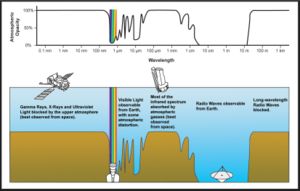
Human eyes respond to light with wavelength in the range of approximately 400 to 700 nm. Other animals have other ranges, with many such as birds including a significant ultraviolet (shorter than 400 nm) response.
Dynamic range
The retina has a static contrast ratio of around 100:1 (about 6 1/2 stops). As soon as the eye moves ( saccades) it re-adjusts its exposure both chemically and by adjusting the iris. Initial dark adaptation takes place in approximately four seconds of profound, uninterrupted darkness; full adaptation through adjustments in retinal chemistry (the Purkinje effect) are mostly complete in thirty minutes. Hence, a dynamic contrast ratio of about 1,000,000:1 (about 20 stops) is possible. The process is nonlinear and multifaceted, so an interruption by light merely starts the adaptation process over again. Full adaptation is dependent on good blood flow; thus dark adaptation may be hampered by poor circulation, and vasoconstrictors like alcohol or tobacco.
Eye movement
The visual system in the brain is too slow to process information if the images are slipping across the retina at more than a few degrees per second. Thus, for humans to be able to see while moving, the brain must compensate for the motion of the head by turning the eyes. Another complication for vision in frontal-eyed animals is the development of a small area of the retina with a very high visual acuity. This area is called the fovea, and covers about 2 degrees of visual angle in people. To get a clear view of the world, the brain must turn the eyes so that the image of the object of regard falls on the fovea. Eye movements are thus very important for visual perception, and any failure to make them correctly can lead to serious visual disabilities.
Having two eyes is an added complication, because the brain must point both of them accurately enough that the object of regard falls on corresponding points of the two retinas; otherwise, double vision would occur. The movements of different body parts are controlled by striated muscles acting around joints. The movements of the eye are no exception, but they have special advantages not shared by skeletal muscles and joints, and so are considerably different.
Extraocular muscles
Each eye has six muscles that control its movements: the lateral rectus, the medial rectus, the inferior rectus, the superior rectus, the inferior oblique, and the superior oblique. When the muscles exert different tensions, a torque is exerted on the globe that causes it to turn, in almost pure rotation, with only about one millimeter of translation. Thus, the eye can be considered as undergoing rotations about a single point in the centre of the eye. Once the human eye sustains damage to the optic nerve, the impulses will not be taken to the brain. Eye transplants can happen but the person receiving the transplant will not be able to see. As for the optic nerve, once it is damaged it cannot be fixed.
Rapid eye movement
Rapid eye movement, or REM for short, typically refers to the stage during sleep during which the most vivid dreams occur. During this stage, the eyes move rapidly. It is not in itself a unique form of eye movement.
Saccades
Saccades are quick, simultaneous movements of both eyes in the same direction controlled by the frontal lobe of the brain.
Microsaccades
Even when looking intently at a single spot, the eyes drift around. This ensures that individual photosensitive cells are continually stimulated in different degrees. Without changing input, these cells would otherwise stop generating output. Microsaccades move the eye no more than a total of 0.2° in adult humans.
Vestibulo-ocular reflex
The vestibulo-ocular reflex is a reflex eye movement that stabilizes images on the retina during head movement by producing an eye movement in the direction opposite to head movement, thus preserving the image on the centre of the visual field. For example, when the head moves to the right, the eyes move to the left, and vice versa.
Smooth pursuit movement
The eyes can also follow a moving object around. This tracking is less accurate than the vestibulo-ocular reflex, as it requires the brain to process incoming visual information and supply feedback. Following an object moving at constant speed is relatively easy, though the eyes will often make saccadic jerks to keep up. The smooth pursuit movement can move the eye at up to 100°/s in adult humans.
It is more difficult to visually estimate speed in low light conditions or while moving, unless there is another point of reference for determining speed.
Optokinetic reflex
The optokinetic reflex is a combination of a saccade and smooth pursuit movement. When, for example, looking out of the window at a moving train, the eyes can focus on a 'moving' train for a short moment (through smooth pursuit), until the train moves out of the field of vision. At this point, the optokinetic reflex kicks in, and moves the eye back to the point where it first saw the train (through a saccade).
Vergence movement
When a creature with binocular vision looks at an object, the eyes must rotate around a vertical axis so that the projection of the image is in the centre of the retina in both eyes. To look at an object closer by, the eyes rotate 'towards each other' ( convergence), while for an object farther away they rotate 'away from each other' ( divergence). Exaggerated convergence is called cross eyed viewing (focusing on the nose for example) . When looking into the distance, or when 'staring into nothingness', the eyes neither converge nor diverge.
Vergence movements are closely connected to accommodation of the eye. Under normal conditions, changing the focus of the eyes to look at an object at a different distance will automatically cause vergence and accommodation.
Diseases, disorders, and age-related changes
There are many diseases, disorders, and age-related changes that may affect the eyes and surrounding structures.
As the eye ages certain changes occur that can be attributed solely to the aging process. Most of these anatomic and physiologic processes follow a gradual decline. With aging, the quality of vision worsens due to reasons independent of aging eye diseases. While there are many changes of significance in the nondiseased eye, the most functionally important changes seem to be a reduction in pupil size and the loss of accommodation or focusing capability ( presbyopia). The area of the pupil governs the amount of light that can reach the retina. The extent to which the pupil dilates also decreases with age. Because of the smaller pupil size, older eyes receive much less light at the retina. In comparison to younger people, it is as though older persons wear medium-density sunglasses in bright light and extremely dark glasses in dim light. Therefore, for any detailed visually guided tasks on which performance varies with illumination, older persons require extra lighting. Certain ocular diseases can come from sexually transmitted diseases such as herpes and genital warts. If contact between eye and area of infection occurs, the STD will be transmitted to the eye.
With aging a prominent white ring develops in the periphery of the cornea- called arcus senilis. Aging causes laxity and downward shift of eyelid tissues and atrophy of the orbital fat. These changes contribute to the etiology of several eyelid disorders such as ectropion, entropion, dermatochalasis, and ptosis. The vitreous gel undergoes liquefaction ( posterior vitreous detachment or PVD) and its opacities—visible as floaters—gradually increase in number.
Various eye care professionals, including ophthalmologists, optometrists, and opticians, are involved in the treatment and management of ocular and vision disorders. A Snellen chart is one type of eye chart used to measure visual acuity. At the conclusion of an eye examination, an eye doctor may provide the patient with an eyeglass prescription for corrective lenses. Some disorders of the eyes for which corrective lenses are prescribed include myopia (near-sightedness) which affects one-third of the population, hyperopia (far-sightedness) which affects one quarter of the population, and presbyopia, a loss of focusing range due to aging.
Eye injury and safety
Accidents involving common household products cause 125,000 eye injuries each year in the U.S. More than 40,000 people a year suffer eye injuries while playing sports. Sports-related eye injuries occur most frequently in baseball, basketball and racquet sports.
Occupational eye injury
Each day about 2000 U.S. workers have a job-related eye injury that requires medical treatment. About one third of the injuries are treated in hospital emergency departments and more than 100 of these injuries result in one or more days of lost work. The majority of these injuries result from small particles or objects striking or abrading the eye. Examples include metal slivers, wood chips, dust, and cement chips that are ejected by tools, wind blown, or fall from above a worker. Some of these objects, such as nails, staples, or slivers of wood or metal penetrate the eyeball and result in a permanent loss of vision. Large objects may also strike the eye/face causing blunt force trauma to the eyeball or eye socket. Chemical burns to one or both eyes from splashes of industrial chemicals or cleaning products are common. Thermal burns to the eye occur as well. Among welders, their assistants, and nearby workers, UV radiation burns ( welder’s flash) routinely damage workers’ eyes and surrounding tissue.
In addition to common eye injuries, health care workers, laboratory staff, janitorial workers, animal handlers, and other workers may be at risk of acquiring infectious diseases via ocular exposure.
Cuisine
In some countries, stuffed cow's eyes are considered a delicacy. They are made by first removing the vitreous humor, lens, cornea, and iris, then are usually boiled. Cow eyes are often stuffed with varieties of coleslaw, beef, and even cream cheese.
Seal eyes are eaten by the Inuit, providing a source of zinc in their diet.
A delicacy in western Norwegian cuisine is the singed head of a sheep or lamb, smalahovud, where the eyes are also eaten.

